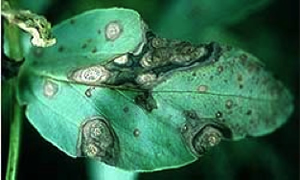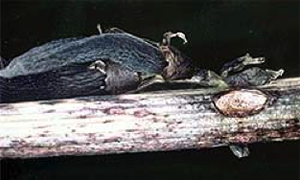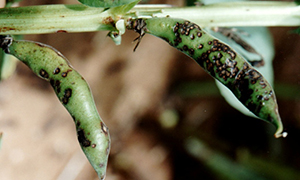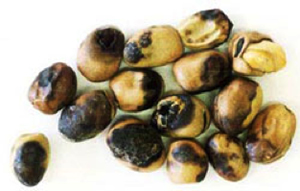Ascochyta leaf and pod spot of faba bean
Ascochyta leaf and pod spot is an important disease of faba beans in Victoria and South Australia. This disease can be managed through an integrated approach including:
- careful paddock selection
- the use of resistant varieties
- strategic use of foliar fungicides.
What to look for
Symptoms occur on leaves, stems and pods of infected plants, and can be confused with the early stages of chocolate spot.




On leaves, small, circular, dark-brown spots appear first. As the disease develops, lesions enlarge and turn light and then change to dark grey in colour. They become irregular in shape, often zonate, and may coalesce to cover most of the leaf surface. Leaf tissue next to the lesions may become black and necrotic. Within the lesions, numerous pinhead- sized black fruiting bodies (pycnidia) of the fungus develop. These appear only under moist conditions and are often concentrically arranged (Figure 1).
On the stem, lesions are more elongated, sunken and darker than leaf lesions and are usually covered with scattered pycnidia (Figure 2). Stems may split and break at the point of infection causing plants to lodge.
On pods, lesions are sunken and have pale centre and dark margins; they can be covered by numerous pycnidia (Figure 3). Well developed lesions can penetrate the pod and infect developing seeds causing them to be shrunken and discoloured.
Badly infected seeds have yellowish-brown stains on the outer seed coat, which considerably reduces its market value (Figure 4).
Late infection with ascochyta can sometimes cause seed staining when disease levels in the crops have appeared too low to warrant fungicides sprays.
Disease cycle
Ascochyta leaf and pod spot is caused by the fungus Ascochyta fabae. The fungus can survive on crop debris, self-sown volunteer plants, and infected seed.
The disease usually becomes established when spores of the fungus, produced on old bean stubble, are carried into the new crop.
Wet conditions are required for infection. During wet weather the disease can spread from infected to healthy plants by rain splash and wind-borne spores. Infection may occur at any stage of plant growth, providing there has been either rain or heavy dew. The disease is usually most severe early in wet years.
Economic importance
The disease is widespread in southern Australia. Its severity varies considerably from crop to crop and between seasons. Yield losses of 10 to 30 per cent can occur in seasons favourable for the disease. Discolouration of seed can seriously reduce its market value.
Management
An integrated approach is the key to successful management of ascochyta blight in faba bean.
Variety selection
Select the variety with the highest level of resistance to the important disease risk in your district.
Seed selection
Aim to use the 'cleanest' seed possible with 5 per cent to nil levels of ascochyta present.
Seed should be sourced from the 'cleanest' crops. Old, frosted or damaged seed may have reduced germination and reduced vigour.
Faba bean seed that has greater than 25 per cent seed coat discolouration can reduce the emergence of seed by 30 per cent. Seed that has less than five per cent seed coat discolouration will usually have normal levels of germination
Paddock selection
A break of at least 3 years should be observed between faba bean crops.
Aim to separate this year's faba bean crop from last year's faba bean stubble by a distance of 500m.
Reduce disease risk by not sowing adjacent to vetch, chickpea or lentil stubble.
Sowing rate
Follow the recommended sowing rates for your district, remember that rates may vary between varieties.
Plan to sow within the optimum sowing window for your district.
Strategic use of foliar fungicides
Fungicide strategies are more effective if applied prior to infection.
A successful fungicide program relies on crop monitoring, correct disease identification and timeliness of spraying with the correct product. Early sprays must be applied at the first sign of disease to be effective.
Late sprays are unlikely to significantly reduce the incidence and severity of disease on the leaves and stems. However, late sprays are often beneficial as they can decrease the severity of ascochyta on pods and reduce seed discolouration.
Harvest
Plan to harvest as early as possible to minimise discolouration of seed caused by ascochyta infection.
Further references
Detailed information on each of the pulse diseases can be obtained from:
- Pulse Australia
- National Variety Trials
- Victorian Winter Crop Summary
- Seed Health Testing in Pulse Crops
- Blackspot Management Guide for Victoria
Contact
Dr Joshua Fanning
Pulse Pathologist – Horsham
0419 272 075
Field Crops Pathology
Grains Innovation Park
110 Natimuk Rd
Horsham 3400
03 5450 8301
Or call the Customer Service Centre, 136 186
Acknowledgments
Helen Richardson, Trevor Bretag, Horsham and Luise Sigel, Agriculture Victoria, Horsham. Support by the Grains Research and Development Corporation is gratefully acknowledged.